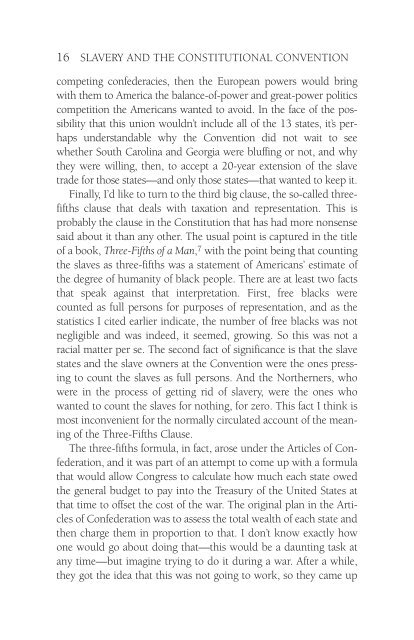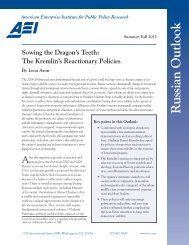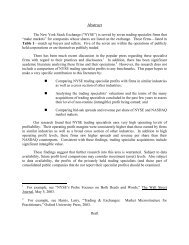Download the PDF - American Enterprise Institute
Download the PDF - American Enterprise Institute
Download the PDF - American Enterprise Institute
Create successful ePaper yourself
Turn your PDF publications into a flip-book with our unique Google optimized e-Paper software.
16 SLAVERY AND THE CONSTITUTIONAL CONVENTION<br />
competing confederacies, <strong>the</strong>n <strong>the</strong> European powers would bring<br />
with <strong>the</strong>m to America <strong>the</strong> balance-of-power and great-power politics<br />
competition <strong>the</strong> <strong>American</strong>s wanted to avoid. In <strong>the</strong> face of <strong>the</strong> possibility<br />
that this union wouldn’t include all of <strong>the</strong> 13 states, it’s perhaps<br />
understandable why <strong>the</strong> Convention did not wait to see<br />
whe<strong>the</strong>r South Carolina and Georgia were bluffing or not, and why<br />
<strong>the</strong>y were willing, <strong>the</strong>n, to accept a 20-year extension of <strong>the</strong> slave<br />
trade for those states—and only those states—that wanted to keep it.<br />
Finally, I’d like to turn to <strong>the</strong> third big clause, <strong>the</strong> so-called threefifths<br />
clause that deals with taxation and representation. This is<br />
probably <strong>the</strong> clause in <strong>the</strong> Constitution that has had more nonsense<br />
said about it than any o<strong>the</strong>r. The usual point is captured in <strong>the</strong> title<br />
of a book, Three-Fifths of a Man, 7 with <strong>the</strong> point being that counting<br />
<strong>the</strong> slaves as three-fifths was a statement of <strong>American</strong>s’ estimate of<br />
<strong>the</strong> degree of humanity of black people. There are at least two facts<br />
that speak against that interpretation. First, free blacks were<br />
counted as full persons for purposes of representation, and as <strong>the</strong><br />
statistics I cited earlier indicate, <strong>the</strong> number of free blacks was not<br />
negligible and was indeed, it seemed, growing. So this was not a<br />
racial matter per se. The second fact of significance is that <strong>the</strong> slave<br />
states and <strong>the</strong> slave owners at <strong>the</strong> Convention were <strong>the</strong> ones pressing<br />
to count <strong>the</strong> slaves as full persons. And <strong>the</strong> Nor<strong>the</strong>rners, who<br />
were in <strong>the</strong> process of getting rid of slavery, were <strong>the</strong> ones who<br />
wanted to count <strong>the</strong> slaves for nothing, for zero. This fact I think is<br />
most inconvenient for <strong>the</strong> normally circulated account of <strong>the</strong> meaning<br />
of <strong>the</strong> Three-Fifths Clause.<br />
The three-fifths formula, in fact, arose under <strong>the</strong> Articles of Confederation,<br />
and it was part of an attempt to come up with a formula<br />
that would allow Congress to calculate how much each state owed<br />
<strong>the</strong> general budget to pay into <strong>the</strong> Treasury of <strong>the</strong> United States at<br />
that time to offset <strong>the</strong> cost of <strong>the</strong> war. The original plan in <strong>the</strong> Articles<br />
of Confederation was to assess <strong>the</strong> total wealth of each state and<br />
<strong>the</strong>n charge <strong>the</strong>m in proportion to that. I don’t know exactly how<br />
one would go about doing that—this would be a daunting task at<br />
any time—but imagine trying to do it during a war. After a while,<br />
<strong>the</strong>y got <strong>the</strong> idea that this was not going to work, so <strong>the</strong>y came up






